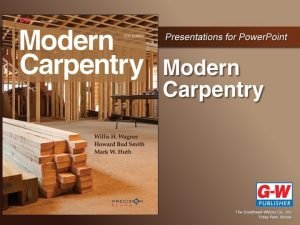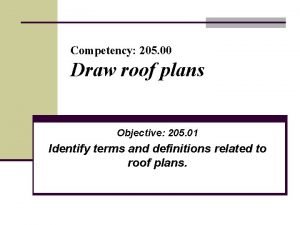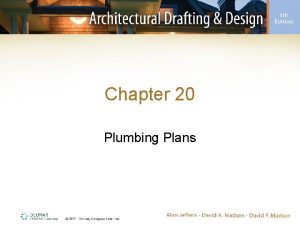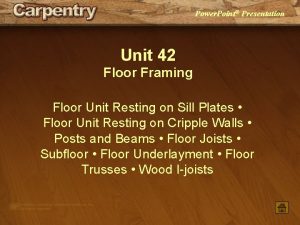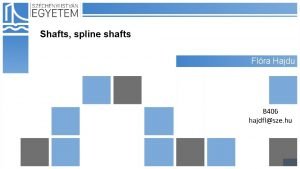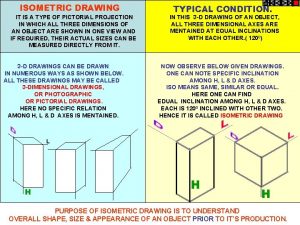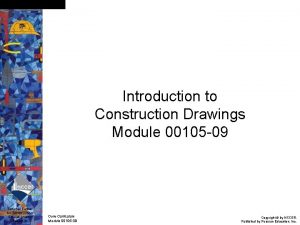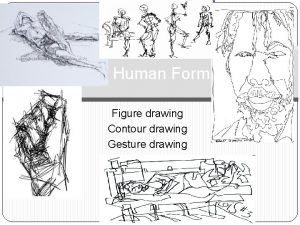Chapter 32 Drawing Framing Plans Introduction A framing























- Slides: 23

Chapter 32 Drawing Framing Plans

Introduction • A framing plan is used to show: – Dimensions – Framing members – Methods of resisting gravity – Seismic loads and wind loads for specific levels of a structure

Managing Components Represented on a Framing Plan • Simple one-level house using truss roof – Architectural and structural information can often be combined on floor plan • Custom multilevel structure – Separate plans are developed for architectural and structural requirements of each level




Managing Components on a Framing Plan (cont’d. ) • Framing members – Key element is to specify locations of: • • • Headers Beams Posts Joists Trusses


Managing Components on a Framing Plan (cont’d. ) • Seismic and wind resistance – Severity of lateral loads will varies • Plywood or OSB shear panels, extra blocking, metal angles, and metal connectors are used to resist forces

Managing Components on a Framing Plan (cont’d. ) • Dimensions – Process is the same as a floor plan • If a separate framing plan is to be drawn, the floor plan is usually not dimensioned • Where joists extend past a wall, cantilever length must be dimensioned • Many professionals place general notes on the framing plan to ensure compliance • Detail reference symbols are also used

Resisting Lateral Loads Using the Prescriptive Path of the Code • Prescriptive design methods – Provided by IRC – Ensure a structure will be able to resist lateral loads • Ceiling and wall heights • Wall placement • Design criteria for wind speeds below 110 mph

Resisting Lateral Loads Using the Prescriptive Path (cont’d. ) • Prescriptive design methods (cont’d. ) – Depending on municipality, prescriptive and design methods may not be allowed on the same house – State and local municipalities altered contents of IRC Section 602. 10—Wall Bracing

Resisting Lateral Loads Using the Prescriptive Path (cont’d. ) • Basic terms and concepts – Shear panel – Braced wall panels and lines • LIB, DWB, WSP, SFB, GB, PBS, PCP, HPS, ABW, PFH, PFG – Alternative braced wall panel – Portal frame with holddowns – Portal frame adjacent to openings at garage – Simpson Strong-Wall

Resisting Lateral Loads Using the Prescriptive Path (cont’d. ) • Combining reinforcement methods – IRC allows bracing methods to be combined • Intermittent bracing methods can be used on one level and continuous sheathing methods on another • Varied intermittent bracing methods can be used within the same level • On single-level homes in seismic design categories A, B, and C, varied methods of intermittent bracing can be used in same braced wall line

Resisting Lateral Loads Using the Prescriptive Path (cont’d. ) • Placement of panels within a braced wall line – May vary depending on local conditions and seismic risk – Follow IRC standards • Refer to the text

Resisting Lateral Loads Using the Prescriptive Path (cont’d. ) • Applying code requirements to a simple home – Required reinforcing depends on: • • • Seismic design category (SDC) Soil class Expected wind speed Number of building levels above braced wall line Method used to construct panel reinforcement

Resisting Lateral Loads Using the Prescriptive Path (cont’d. ) • Continuously sheathed braced wall lines – 3/8" thick sheathing nailed to wall studs with 6 d common nails at 6" O. C. at panel edges and 12" O. C. at intermediate supports – Must be applied to all surfaces of one wall side – CS-G continuous sheathing garage – CS-PF continuous sheathing portal frame

Resisting Lateral Loads Using the Prescriptive Path (cont’d. ) • Support of braced wall lines – For homes constructed with wood floor systems, additional guidelines must be met • Refer to the text • Representing wall reinforcement – Location of wall panels must be clearly marked – Materials may be specified in a table

Completing a Framing Plan • Order used to draw framing plan depends on: – Method of construction – Level to be framed

Roof Framing Plans • Similar to roof plan – Shows structure shape and roof outline – Shows size and direction of framing members used to frame the roof – Varies depending on construction methods (e. g. , trusses or western platform)

Roof Framing Plans (cont’d. ) • Refer to the text for instructions on drawing: – Roof plan base drawing – Gable roof framing plan with truss framing – Gable roof framing plan with rafter framing – Hip roof framing plan with truss framing – Hip roof framing plan with rafter framing – Dutch hip roof framing plan with truss framing – Dutch hip roof framing plan with rafter framing

Floor Framing Plans • Framing plan can be completed by using base drawings for floor plans – Ideally a Mylar copy of the floor plan should be made after walls, doors, windows, and cabinets are drawn – If a copy was not made prior to completing floor plan, layout can be traced • Refer to the text for instructions

Checklists • Refer to the text for: – Roof framing plan checklist • Truss-framed roof • Stick-framed roof – Framing plan checklist • • Braced wall lines Dimension line placement Dimensions Notes
 Longitudinal framing and transverse framing
Longitudinal framing and transverse framing Balloon framing vs platform framing
Balloon framing vs platform framing Transverse framed double bottom
Transverse framed double bottom Mansard roof plan
Mansard roof plan 20 20 plumbing
20 20 plumbing Isometric
Isometric Unit 8 floor framing answers
Unit 8 floor framing answers The marketing plan the central instrument
The marketing plan the central instrument Chapter 24 introduction to animals worksheet answers
Chapter 24 introduction to animals worksheet answers Chapter 2 developing marketing strategies and plans
Chapter 2 developing marketing strategies and plans Freehand sketching in technical drawing
Freehand sketching in technical drawing Scale chapter in engineering drawing
Scale chapter in engineering drawing Technical drawing spline shaft drawing
Technical drawing spline shaft drawing Isometric drawing n1
Isometric drawing n1 Technical drawing and artistic drawing
Technical drawing and artistic drawing Technical drawing terms
Technical drawing terms While drawing isometric view/drawing, scale is reduced by
While drawing isometric view/drawing, scale is reduced by Nccer introduction to construction drawings answers
Nccer introduction to construction drawings answers Ellipse in isometric drawing
Ellipse in isometric drawing Introduction to architectural drawing
Introduction to architectural drawing Lightly drawn lines used for lettering
Lightly drawn lines used for lettering Wood framing components
Wood framing components Wall framing members
Wall framing members What are some visual techniques
What are some visual techniques

